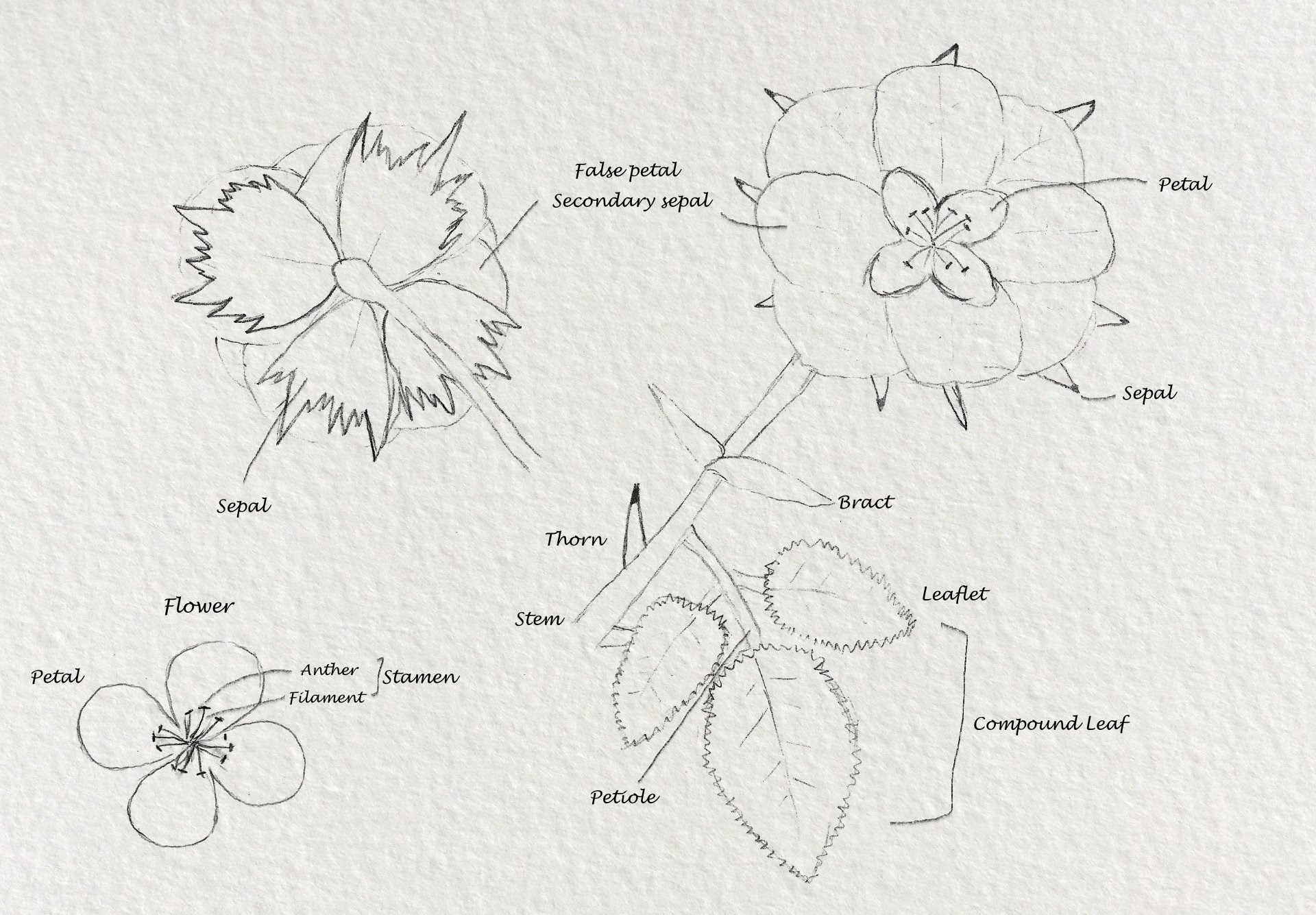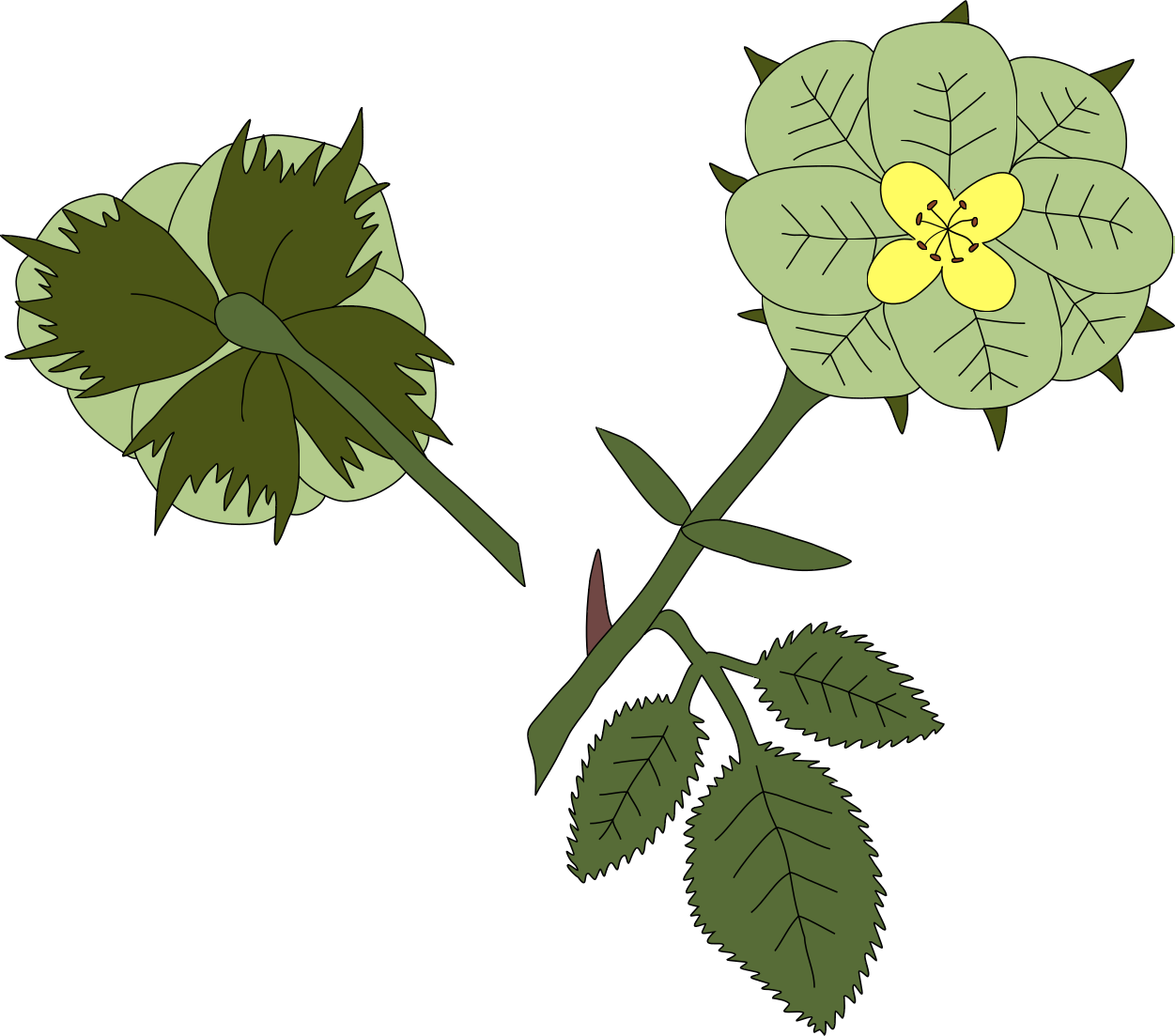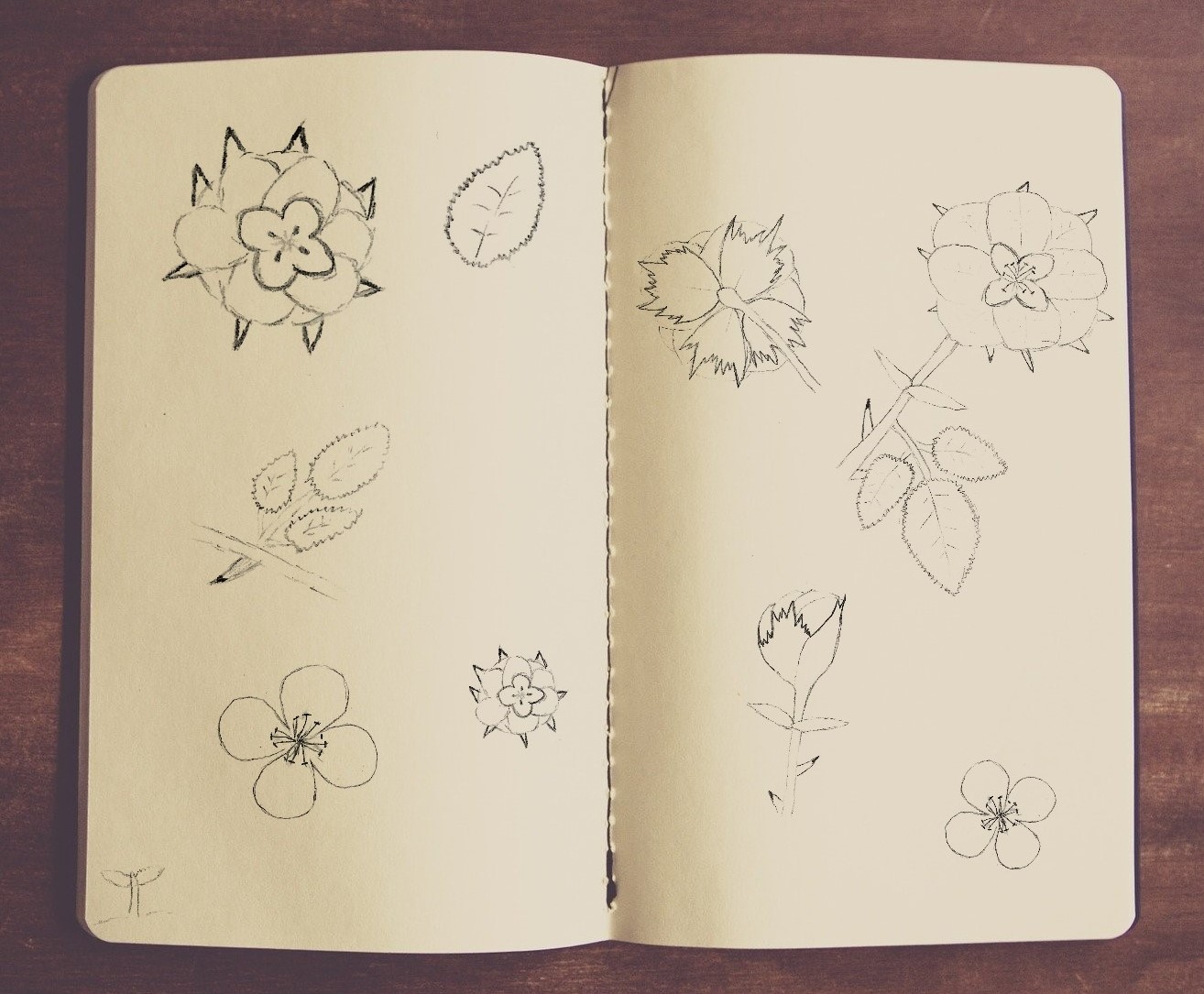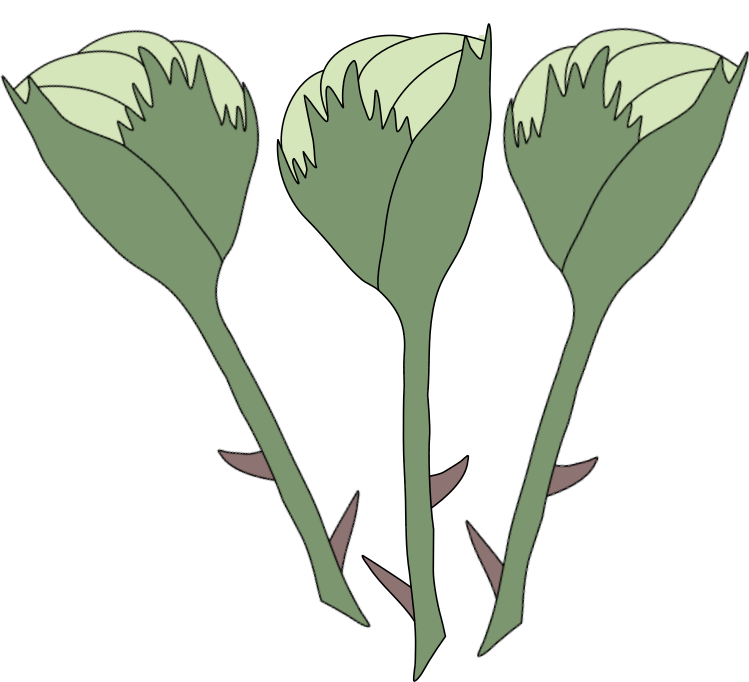The air took on an acerbic quality, burning down my throat and stinging my eyes. And still, I pushed deeper into the garden. I had to find an open bloom, one that had not already been harvested. Wind rustled through the leaves but did not bring relief. It only stirred up more of the plant’s irritating scent, and my vision wavered as my eyes watered.
This job was supposed to be an easy score, and yet already, I was debating whether I wanted to follow through. I touched the charms at my neck, minor restorative and protection charms, to assure myself they were still there before I continued scanning the trellises.
Finally, my attention snagged on the pale center of a deadly bloom. I knew not to touch any part of the plant aside from the delicate flower. I knew to be careful. I reached forward to pinch the edges of the delicate petals when suddenly, a burning sensation ripped through my arm. Fire shot through my veins and the pain consumed me.
I awoke days later in the temple’s infirmary where the healers informed me that I had been pricked by a Temple Guardian thorn. They said I am lucky to keep the arm. I know I am lucky to be alive. How the Torvae monks tend this devil plant, I’ll never know.
- Confession from a novice harvester
What's in a Name?
This rare and ancient flower has been known by many names throughout the years, though more recently, it has become widely referred to as
Temple Guardian. This is largely due to its inclusion in
Torvae Temple gardens and the inner gardens of other sacred sites throughout
Imbria.
Oftentimes, it is trained to climb the archway entrances to these private gardens, and is well labled for all to stay far away. This is thought to be used as a deterrent to keep people from interrupting the monks, priestesses, and acolytes who meditate in these inner gardens.
In many other sites throughout
Torverath and
Salaris, it is grown within locked, gated gardens, to protect children and civilians from unintentional contact with the plant.
Often mistaken for a species of climbing rose, its other names include
Death Rose, referring to its toxicity, and
Bleeding Rose, referring to the red-tipped thorns some varietals carry. However, while it may share many features of edible roses, it is neither a rose nor edible.
Morphology
Temple Guardian does not possess any tendrils or suckers, and therefore is not a true climbing vine. However, it can and often is trained to climb trellises and other structures.
Sepal - protective layers
The outer layer surrounding the flower is known as the sepal and serves to protect the delicate flower as it develops. A unique aspect of Temple Guardian is that it possesses two sepal layers.
The outermost sepal for this plant is tough, waxy, and sharp. Coated in the plant's toxic oils, touching this outer sepal can be fatal if the edge cuts the skin.
The inner sepal layer is often green, though in some varietals can be brightly hued. These false petals are delicate but are still extremely poisonous.
Toxic Oils
The oils running through all parts of Temple Guardian are highly poisonous to all humans,
magic-wielding witches and
nomas alike. This oil collects on the surface of the plant, such that touching any part of it can result in skin burns, rashes, and other adverse side effects.
Vapors from these oils evaporate through the plants'
stomataand can irritate the eyes and respiratory pathways.
These oils have been found to be toxic to many species of animals as well and can even drip from the plant when it is damaged or has access to too much water.
Flowers
Temple Guardian flowers are comprised of four petals ranging in color from pale yellow to burnished gold. The stamen in the center are often shades of orange.
These flowers have a light, pleasing scent that belie their toxicity. They are very delicate and fragile.
Temple Guardian blooms twice a year, in mid-spring and late fall, likely to protect the inner flowers from harsh sun and heat.
Cane - Stem
Often misidentified as vines, Temple Guardian produces long canes that can grow longer than the height of two grown men.
As the plant ages, this cane becomes thick, woody, and often deepens in color, even to a dark red. The deep, blood red color is comon in old growth.
Reproduction
Temple Guardian is slow to mature and not a very prolific plant. Its flowers produce few seeds, which are fragile and rely on a specific lizard to disperse them any significant distance.
From Seed
Temple Guardian seeds require very specific conditions, including a dormancy period, in order to germinate. Gardeners report excedingly low rates of success with sprouting these seeds.
Furthermore, the survival rate of seedlings is low and growth at this stage is fairly slow compared to other plants. Additionally, seedlings cannot thrive when sprouted too close to an established plant.
Stem Cutting
The preferred method for propagating garden-grown Temple Guardian is to root a stem cutting - cut a length of new growth, strip it of most its leaves and buds, and plant in a humid environment.
This method is not always successful and comes with many challenges, specifically in protecting gardeners from the toxins as they handle and care for the plant, which can be slow to take root.
Gardening
While most Temple Guardian today is found in gardens, it is still a rare plant. Most people do not suspect the plant's utility and many gardeners are not willing to risk being near it. It is almost never found in home gardens.
However, in some gardening circles, growing Temple Guardian is a worthy challenge.
For these groups, a healthy, old-growth plant is a mark of pride and seen as both a great accomplishment and symbol of status, given its difficulty and expense to obtain and care for.
I'll never understand why Ethyl grows that cursed Devil Vine. Why would you want that thing anywhere near you?— Salarian Citizen
Symbiosis
This small lizard native to Imbria is the only known creature immune to Temple Guardian's poisons. It is often seen escaping predators by darting into the nearest tangle of Temple Guardian or climbing its trellised vines until out of reach.
The small, delicate seeds of the plant stick to the lizard's skin and thereby are transported to new locations. This is such a vital part of the plant's ability to reproduce that in years when the lizard population declines, so too does the rate of new wild growth of Temple Guardian.
Uses
Poisons
Temple Guardian has long been used in a variety of poisons and dangerous potions. Despite this practice being outlawed, Temple Guardian flower petals, essense, oils, and other products can still be found in the back rooms of potion shops throughout
Imbria.
Poison Arrows
Early peoples of
Wennovi are known to have coated arrowheads and other weapons with the plant's oils. This practice continued well into the
Divided Era, though it has become far less common in the last couple centuries.
Healing Salve
The small petals at the center of a
Temple Guardian bloom are the most highly valued part of the plant, as they are used in the production of healing potions and salves.
Most healing salves are created by the
Torvae monks and priestesses in
Torverath or come from one of the many schools of healing
magic there.
Its primary purpose is to reduce pain, though it will also quicken and improve healing. It is most commonly used for treating burns and other injuries and is most effective when coupled by healing magic from a skilled healer or priestess.
I have to get this dilution perfect. Too little and it's useless. Too much and people wind up with PLN, or worse.— Healer
Do not touch!
All parts of this plant are poisonous
- Contact with any part of this plant may result in painful blisters and rash, which may easily spread to other parts of the body
- The plant's oils release caustic vapors that can irritate the eyes and respiratory pathways
- Direct contact with the eye can result in permanent blindness
- Contact with the bloodstream, as when pricked by a thorn, can lead to fever, widespread rashes, organ failure, paralysis, and even death
- Ingesting any part of the plant is often fatal
Alternate Names
Death Rose
Bleeding Rose
Devil Vine
Conservation Status
Threatened in the wild
Grown throughout:
And southern regions of:
Ecology & Habitat
Native to Imbria,
Temple Guardian grows well in a range of temperate climates. It cannot grow in desert conditions, tropical climates, extreme heat, or extreme cold.
Despite this large natural range, Guardian Temple remains fairly rare in the wild due to low reproduction, slow growth, and human activity. Though, it is believed to have once been much more abundant.
Human activity includes:
- Damage and destruction of plants while harvesting for poisons - common during the Paltetia Revolution, though continues today
- Intentional clearing for safety and to combat poison creation
- Cultivation of lands, urban development, and other habitat loss
History
Discovery
It is unknown who first discovered this plant or when. Images of the flower have been found in ancient texts, but its ancient uses have been lost to time. Historians theorize it has been used in poisons for centuries, or perhaps even millennia.
Name Change
In the early
400s DE, explorers found
Death Rose growing in the ruins of a small Torvae temple. It appeared to have been intentionally grown.
This launched renewed interest in the nearly forgotten and generally reviled plant, as historians, scholars, other researchers began to study it and Torvae monks took an interest in growing it in their gardens.
Once researchers discovered its petals' numbing properties at low concentrations, the plant became far more valuable to the temples and schools of healing. It soon became a prominent species grown in temple gardens and has become more widely known as
Temple Guardian.
Na'arin's Bouquet
Receiving one or more unopened blooms of this plant is known as
Na'arin's Bouquet, and is considered to be a death threat or omen of ill fortune.
While this practice is both illegal and uncommon in modern times, historical records indicate that multiple assassin groups throughout history have used this particular plant as a calling card of sorts. If the intended recipient did not succumb to the bouquet's poisons, they could expect to soon receive a visit from an assassin.





















I see the article is still in progress. So maybe there is a chance that you are still planning to write about this. But just in case, I'll ask: why is this plant so toxic? Why is this plant investing so many resources in producing so many ways to kill creatures? I understand if that is not the topic nor intention with creating/writing this plant, but it strikes me as odd to have such a deadly plant with no (apparent) rhyme or reason as to why is it so deadly.
Why is the manchineel so ridiculously poisonous ¯\_(ツ)_/¯ ? Seriously though, this is a good question that I do intend to address. This article is just taking me a long time to write for some reason. Probably because I keep pondering art instead of writing :) Basically, it does have medicinal purposes, when diluted and properly prepared. It is a fairly rare plant that does not reproduce well, and therefore relies on defense mechanisms. It has long been utilized in poisons and more recently medicines, and has a secondary benefit of protecting gardens from intruders, both human and other mammals - so I imagine a bit of selective breeding for toxicity. And I'm considering giving it a species immune to its toxins, such as the iguana with the manchineel, such that there is some sort of symbiotic relationship. Thank you for your comment, and I am open to suggestions for improvment :)
such as properly spelling improvement :)